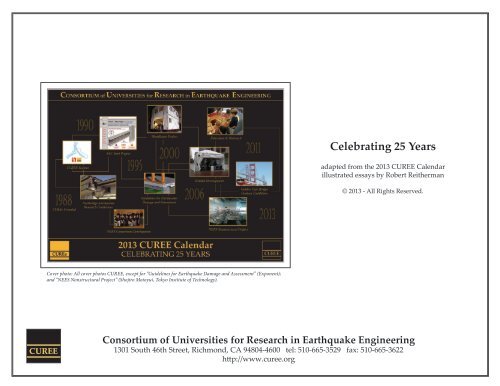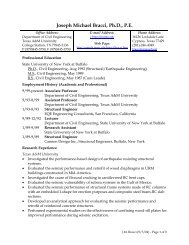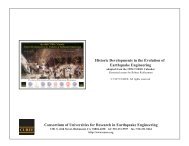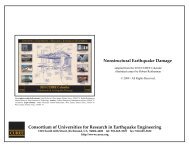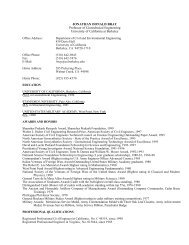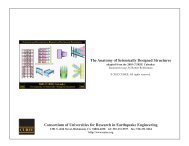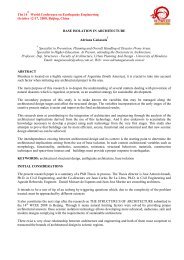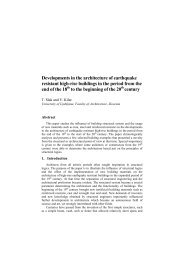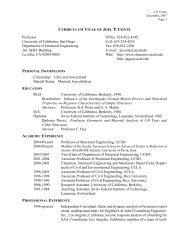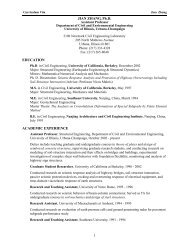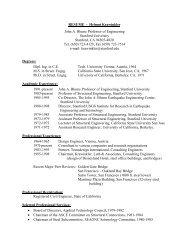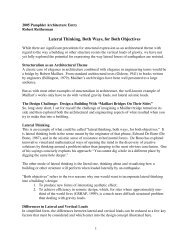Celebrating 25 Years - CUREe
Celebrating 25 Years - CUREe
Celebrating 25 Years - CUREe
Create successful ePaper yourself
Turn your PDF publications into a flip-book with our unique Google optimized e-Paper software.
<strong>Celebrating</strong> <strong>25</strong> <strong>Years</strong><br />
adapted from the 2013 CUREE Calendar<br />
illustrated essays by Robert Reitherman<br />
© 2013 - All Rights Reserved.<br />
Cover photo: All cover photos CUREE, except for “Guidelines for Earthquake Damage and Assessment” (Exponent);<br />
and “NEES Nonstructural Project” (Shojiro Motoyui, Tokyo Institute of Technology).<br />
CUREE<br />
Consortium of Universities for Research in Earthquake Engineering<br />
1301 South 46th Street, Richmond, CA 94804-4600 tel: 510-665-3529 fax: 510-665-3622<br />
http://www.curee.org
CUREE Organizational Description<br />
The Consortium of Universities for Research in Earthquake Engineering (CUREE), is a non-profit organization incorporated in 1988 whose purpose is the advancement of<br />
earthquake engineering research, education, and implementation. As of Fall, 2011, there are 22 member universities in the organization, and approximately <strong>25</strong>0 individual<br />
professors belong to CUREE.<br />
Universities + Research + Earthquakes + Engineering<br />
CUREE is focused on four things, as its name clearly indicates: universities, research, earthquakes, and engineering. In recent years, it has also branched out beyond the<br />
earthquake topic to touch on other civil engineering themes, and it has mounted several exhibitions to extend education to the realm of engaging the general public in exploring<br />
engineering concepts.<br />
CUREE Past-Presidents<br />
Wilfred Iwan<br />
Caltech<br />
1988 - 1991<br />
Haresh Shah<br />
Stanford University<br />
1992 - 1993<br />
Stephen Mahin<br />
UC Berkeley<br />
1994 - 1996<br />
Helmut Krawinkler<br />
Stanford University<br />
1997 - 1998<br />
James Beck<br />
Caltech<br />
1998 - 1999<br />
Karl Romstad<br />
UC Davis<br />
1999<br />
Gerard Pardoen<br />
UC Irvine<br />
1999 - 2001<br />
André Filiatrault<br />
UC San Diego *<br />
2001 - 2002<br />
Roberto Leon<br />
Georgia Tech **<br />
2003 - 2004<br />
Andrew Whittaker<br />
University at Buffalo, SUNY<br />
2005 - 2011<br />
* affiliation at time of presidency, now at University at Buffalo, SUNY<br />
** affiliation at time of presidency, now at Virginia Polytechnic Institute and State University
President’s Message<br />
2013 marks the <strong>25</strong>th anniversary of CUREE. With this milestone, we<br />
reflect not only on CUREE’s past contributions to advancing the earthquake<br />
engineering profession, but also on what our contributions will be<br />
in the future.<br />
CUREE has 22 University Members, each with a designated CUREE<br />
member on the faculty who serves as that University’s Representative. To<br />
build a future vision, we organized a meeting of the Member University<br />
Representatives in August, 2012, in San Francisco to discuss how to best<br />
leverage our organization’s resources through new projects and directions<br />
that CUREE can pursue. One of the outcomes of this meeting was a list<br />
of research topics that have the potential to leave an important and lasting<br />
impact in the earthquake engineering field and that can involve CUREE.<br />
Based on these topics, a competitive call for proposals for seed-funding to<br />
be provided by CUREE was put out to the CUREE membership in October.<br />
That membership comprises about <strong>25</strong>0 professors who have been admitted<br />
by the Board of Directors one-by-one based on their qualifications in the<br />
field. We had an excellent response to the RFP, and in 2013 CUREE will be<br />
funding several promising initiatives. We hope to continue providing our<br />
members and practicing engineers with excellent services by having these<br />
seed-funds bear fruit.<br />
At times we can find ourselves overwhelmed with so many activities and so<br />
many professional societies that we forget what each organization is about.<br />
As a reminder, according to the CUREE website (www.curee.org), CUREE<br />
represents “the interests and capabilities of engineering faculty members<br />
and programs in developing research projects that mobilize these capabilities<br />
in the effort to solve significant earthquake problems.” Education within<br />
academia and also education of the public about civil engineering are also<br />
within the organization’s scope. Past projects have also typically involved<br />
practicing engineers in the field. We have benefited greatly over the years<br />
from the contributions made by the Directors on our Board who represent<br />
professional practice. We have also been gratified to see how much of benefit<br />
to both practice and academia has come from the past several years of<br />
CUREE’s collaboration with the Applied Technology Council conducting<br />
projects for the National Institute of Standards<br />
and Technology, the lead agency for the National<br />
Earthquake Hazards Reduction Program.<br />
I would like to emphasize that CUREE represents<br />
our members and we are here to assist you with<br />
developing research that benefits society by<br />
utilizing your expertise and providing opportunities<br />
for your students. Further, we are currently a free service to our membership.<br />
What other professional organization can say all of this We encourage you<br />
therefore to take advantage and become involved. For example, you can work<br />
with CUREE to develop a research team and to head up large (or even small)<br />
projects. While CUREE’s expertise is centered in the earthquake engineering<br />
sub-discipline, other aspects of civil engineering are also of interest to our<br />
members. I look forward to seeing CUREE develop new initiatives in the<br />
future with the talented members that it represents.<br />
In the past, we have been successful in working together to advance the field<br />
thanks to the hard work of our staff, Executive Director Bob Reitherman,<br />
Associate Executive Director Reed Helgens, and Media Manager Darryl<br />
Wong, and to our past presidents, the professors pictured on the previous<br />
page who deserve credit for taking the time from their busy careers to<br />
lead the organization. Over a hundred different individuals have served as<br />
members of the Board of Directors, serving without pay to provide their<br />
guidance for our non-profit corporation. Several hundred professors and<br />
their students have been funded on CUREE projects, providing the expertise<br />
that has made our initiatives successful. Some of the fruits of the efforts of<br />
all these individuals are highlighted in the following pages of the calendar,<br />
accomplishments for which they can justly be proud.<br />
Maria Moreyra Garlock<br />
President, Consortium of Universities for Research in Earthquake Engineering<br />
Associate Professor of Civil and Environmental Engineering, Princeton University
March 1, 1988 marks the date of incorporation of the Consortium of<br />
Universities for Research in Earthquake Engineering (CUREE) as a<br />
non-profit public benefit organization, although the name at that point was<br />
California Universities for Research in Earthquake Engineering. The name<br />
change relates to one of the steps in the evolution of the organization that<br />
occurred a dozen years later, one of a few significant phases covered here.<br />
But first, a necessary preamble back to the years prior to 1988.<br />
In the 1960s, the National Science Foundation (NSF) annually funded<br />
earthquake engineering research via grants to universities at about the $1<br />
million level, for example $1,045,600 in 1967 (Gaus 1969, p. 11), or $7.2<br />
million in 2012 dollars. The current figure is approximately $50 million,<br />
of which $12 million is earmarked for research that must use the Network<br />
for Earthquake Engineering Simulation (NEES), and a little less than twice<br />
that, $20 to $23 million in recent years, for the maintenance and operation<br />
of the NEES laboratories at 14 universities and an extensive information<br />
technology system (National Science Foundation 2011, Facilities appendix,<br />
pp. 47-48).<br />
The destruction of the 1964 Alaska and especially<br />
the 1971 San Fernanado Earthquakes provided<br />
the momentum that helped to pass the National<br />
Earthquake Hazards Reduction Act in October<br />
1977 and the resulting National Earthquake<br />
Hazards Reduction Program (NEHRP). NSF<br />
began to annually receive, in round numbers,<br />
$20 million a year for its earthquake engineering<br />
and social science disaster grants. Borrowing a<br />
term from the geologists, who use saltation to<br />
refer to the way particles such as sand rolling<br />
along in the wind can be suddenly bumped<br />
into the air and leap forward, this was a major saltation in the funding for<br />
earthquake engineering research in the United States.<br />
A Short History of CUREE<br />
by Robert Reitherman, Executive Director<br />
Collapsed highways during the<br />
1971 San Fernando Earthquake<br />
source: R. Kachadoorian (121c),<br />
US Geological Survey<br />
In 1996, after a national contest, NSF awarded $5 million annually for<br />
a decade for a national center for earthquake engineering research, that<br />
being its exact title, headquartered at the University at Buffalo in the State<br />
University of New York system. The State of New York provided matching<br />
funds. The collaborating universities in NCEER were centered in the<br />
Northeast. In the twenty years after NEHRP was established, a number<br />
of universities around the nation had developed earthquake engineering<br />
programs, whereas in the 1960s, one could point to a much smaller list,<br />
mainly California universities and programs at the University of Illinois,<br />
University of Michigan, and the Massachusetts Institute of Technology<br />
(MIT) (Reitherman 2012, p. 418).<br />
With the passage of time, those who were in the field at the time may have<br />
forgotten how acrimoniously the NSF decision was received in California,<br />
whose entry in the contest, proposing a headquarters at the University of<br />
California at Berkeley with other California universities as collaborating<br />
institutions, was thought by many to be the front runner in the contest. It is<br />
enough of a data point measuring the controversy at the time in this brief<br />
historical review to mention that both California Senators officially protested<br />
the decision and a Government Accounting Office (GAO) report had to<br />
be done to evaluate whether the decision was appropriate (Government<br />
Accounting Office 1987). The GAO found “no evidence that the panel<br />
showed favoritism for one proposal over the other” but concluded NSF staff<br />
should have provided more precise criteria regarding receipt of matching<br />
funds and done a better job of presenting information to the panel.<br />
With NCEER a fact of life to which the<br />
California universities had to adjust, their<br />
efforts turned to forming some type of multiuniversity<br />
organization that could compete for<br />
funds and maintain prominence in the field.<br />
At that time, the Earthquake Engineering<br />
Research Center (EERC) at the University<br />
of California at Berkeley had been growing<br />
U.C. Berkeley shake table
since its establishment in January of 1968, with its shake table in operation<br />
by 1972, but there was nothing like NCEER that was set up specifically to<br />
involve multiple universities.<br />
Thus in 1987, several key individuals among the<br />
California universities, including Bruce Bolt, Wilfred<br />
(Bill) Iwan, and others, took the initiative to set up<br />
California Universities for Research in Earthquake<br />
Engineering, incorporated as a non-profit public benefit<br />
organization on March 1, 1988, and subsequently<br />
Internal Revenue Service 401 (c) status was obtained.<br />
At that time, the acronym was spelled <strong>CUREe</strong>. The<br />
eight founding university members were California<br />
Institute of Technology, Stanford University, the<br />
University of Southern California, and the University<br />
of California campuses at Berkeley, Davis, Irvine, Los<br />
Angeles, and San Diego.<br />
Professor Bruce Bolt<br />
source: UC Berkeley<br />
With the organization in place, the next step was to obtain funding. It<br />
came from afar, from Japan, from the Kajima Corporation. Through the<br />
discussions of some key <strong>CUREe</strong> professors, including Joseph Penzien,<br />
Alfredo H-S. Ang, and Bill Iwan (Penzien 2004,<br />
p. 76), a multi-year <strong>CUREe</strong>-Kajima Joint Research<br />
Program was established. The key person at Kajima<br />
was Takuji Kobori. Kobori had been a professor<br />
at Kyoto University and recognized the value of<br />
academic research to the development of Kajima’s<br />
capabilities. In one two-year or three-year phase after<br />
another, the joint program lasted twenty years, until<br />
2010. The range of topics was very broad, from ground<br />
motion studies to particular structural investigations<br />
Dr. Takuji Kobori<br />
to seismic risk analyses.<br />
Another collaboration with Japan came with the 1989 Loma Prieta<br />
Earthquake. <strong>CUREe</strong> obtained funding from the Building Contractors<br />
Society of Japan to systematically compile geologic and strong motion data.<br />
Following the Northridge Earthquake, <strong>CUREe</strong> obtained funding from all<br />
four NEHRP agencies – NSF, U.S.Geological Survey, National Institute of<br />
Standards and Technology, and Federal Emergency Management Agency –<br />
to bring together researchers and potential users of the research soon after<br />
NEHRP research grants had been issued to study the earthquake. Then,<br />
when enough time had passed for research to be conducted, the second<br />
phase collected papers together in a multi-volume set that remains the most<br />
comprehensive single source of information on that earthquake (<strong>CUREe</strong><br />
1998). This multi-year effort was truly national in scope, and no distinction<br />
was made on the basis of the region of origin of the research. <strong>CUREe</strong> still<br />
had its original California set of members, but had begun to become more<br />
national in its outlook.<br />
Prior to the 1994 Northridge<br />
Earthquake, <strong>CUREe</strong> decided<br />
it needed a small staff to run<br />
the organization, and after a<br />
national search, the author was<br />
selected as executive director.<br />
An office was established at<br />
the University of California<br />
Richmond Field Station in the second floor of the shake table building<br />
through the auspices of Professor Stephen Mahin, who was then president<br />
of <strong>CUREe</strong>. The office has remained there to date. Budgeting, payment<br />
approval, NSF grant reporting, audits, and other financial affairs were put<br />
on a systematic basis, and proposal initiatives were developed. Soon, a large<br />
grant ($5.2 million) from FEMA was obtained for an applied research project<br />
concerning woodframe buildings, whose performance in the Northridge<br />
Earthquake was not as reliable as many engineers had assumed. About the<br />
same time, <strong>CUREe</strong> joined forces with the Structural Engineers Association<br />
of California and the Applied Technology Council to form the SAC Joint<br />
Venture and devote academic and practicing engineer capabilities toward<br />
the problem of solving the welded moment-resisting frame problems that<br />
surfaced in that earthquake. In both cases, <strong>CUREe</strong> developed the ability to<br />
manage over 60 subcontracts and deal uniformly with universities inside
and outside the state, another indication the organization was moving toward<br />
its eventual national, rather than California, composition.<br />
Meanwhile, the ten-year term of NSF funding to NCEER that began in 1986<br />
was nearing an end, and NSF decided to hold another contest, but this time<br />
it left open the possibility of awarding more than one center. The <strong>CUREe</strong><br />
member universities decided that a unified proposal should be developed in<br />
response, and that process started in January of 1986 when Caltech professor<br />
Paul Jennings was appointed head of a committee that had one representative<br />
from each of <strong>CUREe</strong>’s eight member universities. To obtain the required<br />
matching funds from the state, a California Seismic Safety Commission bill<br />
had already been drafted, and <strong>CUREe</strong> was inserted in the bill’s language<br />
to be the entity receiving the funding. After several rounds of meetings of<br />
the Jennings committee, a consensus was reached that U.C. Berkeley should<br />
be the lead university, and <strong>CUREe</strong> then had the bill rewritten to make that<br />
change. By the end of the summer, the bill had passed, and the proposal that<br />
was later to be approved by NSF was funded, creating the Pacific Earthquake<br />
Engineering Research Center, PEER. NCEER morphed into MCEER,<br />
the Multidisciplinary Center for Earthquake Engineering Research, still<br />
headquartered at Buffalo. A new center, MidAmerica Earthquake Center<br />
(MAE) headquartered at the University of Illinois, was the third center<br />
funded by NSF.<br />
<strong>CUREe</strong> once again had adjusted to<br />
the direction taken by NSF, and it<br />
was to adjust again shortly after NSF<br />
decided to devote a large portion of<br />
its earthquake engineering budget<br />
to what became the Network for<br />
Earthquake Engineering Simulation.<br />
Such a network was to be truly<br />
national, whereas the three centers<br />
were regionally focused. <strong>CUREe</strong>’s<br />
experience with the Woodframe and SAC Steel projects gave it confidence<br />
that the landscape of academia in the earthquake engineering field had grown<br />
to be truly national in capabilities, and it decided to open its membership to<br />
universities outside the state. In 2000, the name changed to Consortium of<br />
Universities for Research in Earthquake Engineering and the acronym to<br />
CUREE. Almost immediately, the membership quadrupled. In the dozen<br />
years since its founding, the California-centric membership and outlook of<br />
CUREE had changed markedly.<br />
In the competition to establish NEES, NSF called for a consortium to set<br />
up its administrative hub, in parallel with the competition to decide which<br />
universities would receive large equipment grants for new or enhanced<br />
laboratories. CUREE won that competition and by 2004 had put in place<br />
a new NEES Consortium non-profit organization (Reitherman 2004). In<br />
that instance, it proved the worth of having a truly national association of<br />
universities to bring them together to work toward a common goal.<br />
More projects of the organization are illustrated in the following pages that<br />
show the variety and range of CUREE’s capabilities that have developed<br />
over the years.<br />
References Cited<br />
California Universities for Research in Earthquake Engineering (1998). Proceedings<br />
of the NEHRP conference and workshop on research on the Northridge, California<br />
Earthquake of January 17, 1994. California Universities for Research in Earthquake<br />
Engineering, Richmond, CA, four volumes.<br />
Gaus, Michael (1969). “Earthquake engineering support by the National Science<br />
Foundation,” Report on the NSF-UCEER conference on earthquake engineering<br />
research, Universities Council for Earthquake Engineering Research, Pasadena, CA.<br />
Government Accounting Office (1987). Problems found in decision process for<br />
awarding earthquake center, Washington, DC.<br />
National Science Foundation (2011). National Science Foundation FY 2012 budget<br />
request to congress, National Science Foundation, Arlington, VA.<br />
Penzien, Joseph (2004). Connections: EERI Oral History Series, Joseph Penzien,<br />
Stanley Scott and Robert Reitherman, interviewers, Earthquake Engineering Research<br />
Institute, Oakland, CA.<br />
Reitherman, Robert (2004). “A short history of NEES,”<br />
http://www.curee.org/projects/NEES/history.html.<br />
Reitherman, Robert (2012). Earthquakes and engineers: An international history.<br />
ASCE Press, Reston, VA.
<strong>CUREe</strong><br />
The original logo for this project, based on the Japanese Kanji<br />
symbol for a person, helped to graphically show the relationship<br />
with Japan and CUREE (then a California organization).<br />
Professor Wilfred (Bill) Iwan presents Dr. Masamitsu<br />
Miyamura with a special plaque commemorating twenty<br />
years of collaborative research between CUREE and the<br />
Kajima Corporation.<br />
Collapse of the Hanshin Expressway of Kobe in the January 17, 1995 Great Hanshin (or Hyogo-Ken-Nanbu) Earthquake.<br />
- source: Charles A. Kircher<br />
CUREE<br />
The CUREE-Kajima Joint Research Program<br />
Kajima Corporation traces its origins back to 1840, after which it quickly grew to become an industry leader in the<br />
field of architectural-engineering-construction. Headquartered in Tokyo, Japan, it is a global operation. Through the<br />
efforts of CUREE members such as Wilfred Iwan of Caltech, the partnership of CUREE-Kajima was created, and for 20<br />
years, CUREE was funded by Kajima to engage professors and graduate students, and manage research, in a variety<br />
of research areas. Many CUREE members were project subcontractors and/or members of the Oversight Committee,<br />
working with the highly respected Takuji Kobori, head of the Kobori Research Complex, Inc., until his passing in 2007.<br />
2013<br />
CONSORTIUM of UNIVERSITIES for RESEARCH in EARTHQUAKE ENGINEERING
Test specimen from the SAC Steel Project<br />
<strong>CUREe</strong><br />
From the outset, it was recognized that an interdisciplanary approach to the solution was required, involving practicing<br />
structural engineers, engineering researchers, building officials and other representatives of regulator agencies or<br />
standards-setting organizations.<br />
One of the ductile connections developed from research conducted<br />
after the Northridge Earthquake.<br />
- C-.M. Uang (UC San Diego)<br />
The SAC Steel Project<br />
CUREE<br />
With funding from FEMA and the California Office of Emergency Services, research was conducted to develop solutions<br />
for the identification, evaluation, repair, and modification of damaged welded steel moment frame buildings. Effort was<br />
also devoted to new design and construction approaches. Numerous technical reports and guidelines were produced.<br />
The project concluded in 2000, with the reports and technical studies from the project being archived at the website:<br />
www.sacsteel.org<br />
2013<br />
CONSORTIUM of UNIVERSITIES for RESEARCH in EARTHQUAKE ENGINEERING
The Northridge Earthquake Research Conference -<br />
George Housner speaks at the <strong>CUREe</strong> hosted conference held in 1998 at<br />
Caltech on the topic of the January 17, 1994 Northridge Earthquake.<br />
The first Ph.D in the United States for work specifically in earthquake engineering was<br />
earned by George Housner (1910-2008) in 1941.<br />
Some of the attendees of the first CUREE symposium<br />
honoring George Housner.<br />
CUREE<br />
Housner<br />
Bertero<br />
Kobori<br />
Penzien<br />
Honoring Those Who Helped To Shape Earthquake Engineering<br />
Clough<br />
CUREE is very fortunate to name among its membership, past and present, some of the most respected and internationally<br />
famous engineers in the field of earthquake engineering. We are honored to have hosted symposiums recognizing a few of<br />
these members, and have had occasion to design and present plaques and awards recognizing the achievements by individuals<br />
and organizations who have worked with CUREE in advancing the field of civil engineering. The first symposium held<br />
by CUREE was in honor of George Housner, widely regarded as the founding father of modern earthquake engineering.<br />
Iwan<br />
2013<br />
CONSORTIUM of UNIVERSITIES for RESEARCH in EARTHQUAKE ENGINEERING
CUREE-Caltech Woodframe Project Index Buildings<br />
An index building is a hypothetical but realistic<br />
archetypical design, developed almost to the<br />
point of actual working drawings ("blueprints")<br />
that could be used to construct it.<br />
[Clockwise from top] Damage to apartment buildings with tuck-under parking during 1989<br />
Loma Prieta Earthquake; illustration of torsion; shake table seismic experimentation of a<br />
3-story apartment building with tuck-under parking tested at U.C.Berkeley; a new steel<br />
frame, designed to resist seismic forces was installed and tested to simulate how the<br />
original building could be retrofitted.<br />
For four basic index buildings, three different levels of quality construction were defined. They<br />
were subjected to structural and cost analyses.<br />
CUREE<br />
The CUREE-Caltech Woodframe Project<br />
After the 1994 Northridge Earthquake, CUREE and Caltech teamed together and were awarded funds through FEMA<br />
for the The Earthquake Hazard Mitigation of Woodframe Construction project, or the CUREE-Caltech Woodframe<br />
Project for short. Its goal was to coordinate engineering investigations and implementation activities whose objective<br />
was to significantly reduce earthquake losses to woodframe construction. To tackle this large and multi-faceted<br />
project, it was divided into five interrelated elements, which were managed by CUREE over a five year period. Numerous<br />
publications were generated and are available through the CUREE publications website.<br />
2013<br />
CONSORTIUM of UNIVERSITIES for RESEARCH in EARTHQUAKE ENGINEERING
Equipment Sites<br />
Demonstration of the NEES@UTexas remote<br />
simulator (a.k.a. T-Rex)<br />
Demonstration of the NEES@OSU Tsunami<br />
Wave Basin<br />
System<br />
Integration<br />
Remote<br />
Participation<br />
George E. Brown, Jr.<br />
Professor Bruce Kutter supervising the control room<br />
for the NEES@UCDavis centrifuge.<br />
Remote participation by users with the<br />
NEES@Rensselaer Centrifuge.<br />
Ian Buckle, then NEES president, addresses<br />
attendees of the NEES 1st Annual Meeting.<br />
The original Board of Directors for the<br />
NEES Consortium.<br />
Collaboration<br />
Marta Macias Brown at the First NEES Consortium<br />
Annual Meering in Park City, Utah.<br />
CUREE<br />
NEES Consortium Development Project<br />
In 2001, NSF issued a solicitation to develop a new organization to manage the NEES Collaboratory, at the same time<br />
that fifteen earthquake engineering testing facilities were being developed with NEES funding. After a competitive<br />
process, NSF selected CUREE to start the NEES Consortium. The George E. Brown Jr. Network for Earthquake<br />
Engineering Simulation (NEES) Consortium Development Project involved hundreds of academic and practicing<br />
engineers participating in workshops and organizational development meetings over a three-year period, including<br />
the development of the master budget and proposal for the decade-long operation of NEES.<br />
2013<br />
CONSORTIUM of UNIVERSITIES for RESEARCH in EARTHQUAKE ENGINEERING
At the 2009 NSF CMMI Engineering Research<br />
and Innovation conference, CUREE was one<br />
of the exhibitors providing demonstrations on<br />
seismic response in structures to the local school<br />
children, ages kindergarten to high school.<br />
Exhibits were developed and constructed by<br />
CUREE.<br />
CUREE has toured this E-Defense motorized<br />
shake table model to several venues.<br />
The free month-long public exhibit on earthquake engineering,<br />
funded by the City of San Francisco, drew early morning crowds<br />
on the 100th anniversary of the 1906 earthquake. The time the<br />
of the historic earthquake was 5:12 AM.<br />
Exhibits demonstrating the effect of<br />
the frequency of the shaking and of the<br />
structures.<br />
CUREE<br />
Developing Outreach Opportunities for Earthquake Engineering<br />
To facilitate communications between civil engineers and informal educators (e.g. science museums), NSF funded<br />
CUREE to produce a monograph "Building Bridges Between Civil Engineers and Science Museums," which presented<br />
common concerns and areas of mutual benefit for the engineer and museum exhibit designer. CUREE has also<br />
created outdoor exhibits, traveling exhibits, and customized demonstrations.<br />
2013<br />
CONSORTIUM of UNIVERSITIES for RESEARCH in EARTHQUAKE ENGINEERING
CUSTOM DESIGNED<br />
Some exhibits created by CUREE were funded<br />
by private organizations for display within their<br />
headquarters. These have included displays<br />
on seismic disasters represented by historical<br />
stamps, an 80 foot mural on natural disasters,<br />
and a variable frequency shake table (shown<br />
here) that demonstrates with the models and<br />
accelerograph dynamic response.<br />
The model makers at Graphic Blade Studios used photos to create a precise model of the collapsed<br />
Northridge Meadows apartment complex.<br />
Visitors examine models of apartment<br />
buildings with tuck-under garage parking,<br />
shown with and without retrofit.<br />
CUREE<br />
Exhibit Development<br />
CUREE has designed and/or constructed a wide variety of exhibits for use in public displays or to enhance proposals or<br />
projects. The displays demonstrate earthquake engineering principles, practices, or its history. These exhibits creatively<br />
fulfill the requirement of funding sources to make research results available to the general public. With funding from<br />
SCEC, OES, and NSF, models and interactive displays were created for a children's museum by CUREE for an exhibit<br />
called ShakeZone. To appeal to a wide range of age groups, these exhibits were designed to be both interactive and<br />
visually appealing.<br />
2013<br />
CONSORTIUM of UNIVERSITIES for RESEARCH in EARTHQUAKE ENGINEERING
The content of this document is based upon the most current engineering research<br />
and best practices related to assessment and repair of earthquake damage in<br />
woodframe construction. The target audience of these General Guidelines is<br />
homeowners, contractors, insurance claims representatives, and non-engineers<br />
involved in working with technical consultants and/or post-earthquake damage<br />
assessment of woodframe construction.<br />
Earthquake Ground Motions<br />
and Damage Potential<br />
Fireplaces and Chimneys<br />
Floor, Ceiling, and Roofs<br />
Foundations and<br />
Slab-On-Grade<br />
Walls<br />
Dr. John Osteraas (Exponent) served as lead author and editor of<br />
these General Guidelines. Key contributiong authors were<br />
David Bonowitz, Brian McDonald, Akshay Gupta, John Wren,<br />
Joel Wolf John Fessler, Allison Faris, and Daniel Whang.<br />
Geotechnical Aspects<br />
Mechanical, Electrical, and<br />
Plumbing Systems<br />
CUREE<br />
Establishing Guidelines for Assessment and Repair for Earthquake Damage<br />
The goal of the project was to produce objectively based guidelines that would be used after earthquakes to help<br />
assess damage and determine associated repairs. The motivation for the California Earthquake Authority to fund<br />
such a guideline was the destruction of the 1994 Northridge Earthquake, which raised questions on how to recognize<br />
the difference between cosmetic versus structural damage, and how to make that determination. The guidelines are<br />
available through the CUREE website and have been used thousands of times by insurance companies in training<br />
programs.<br />
2013<br />
CONSORTIUM of UNIVERSITIES for RESEARCH in EARTHQUAKE ENGINEERING
The dimensions of the test bed structure are<br />
23 ft (H) x 12 ft (W) x 60 ft (L)<br />
The Nonstructural Component Simulator (NCS), and the two high<br />
performance six-degrees-of-freedom shake tables at the University<br />
at Buffalo-SUNY NEES site were used to test on partition walls.<br />
Professors Tara Hutchinson (UCSD) and Andre Filiatrault<br />
(UB-SUNY) inspect the failure of a pipe connection.<br />
Testing of full-scale partitions, suspended ceilings, and sprinkler piping layouts mounted on<br />
multiple shake tables at the University of Nevada, Reno.<br />
Nonstructural damage within test structure.<br />
CUREE<br />
Simulation of the Seismic Performance of Nonstructural Systems<br />
NSF awarded a $3.6 million grant to the University of Nevada, Reno (UNR) to study the seismic performance of ceilingpiping-partition<br />
nonstructural systems. The subsystem and system-level full-scale experiments are being conduced at<br />
NEES equipment sites at UNR and University at Buffalo, while UC San Diego, Cornell, Rutherford & Chekene, Georgia<br />
Tech, North Carolina State University, and North Carolina A & T are also involved. CUREE is providing management,<br />
contracting, and education and outreach services, including setting up and maintaining the project website.<br />
www.nees-nonstructural.org<br />
2013<br />
CONSORTIUM of UNIVERSITIES for RESEARCH in EARTHQUAKE ENGINEERING
The NEES City Block team<br />
make adjustments to the<br />
test specimen as they<br />
prepare for the next series<br />
of centrifuge tests at the<br />
NEES@UCDavis facility.<br />
3D Autocad images used to build the models visually before actual<br />
model building occurs to allow for more effective planning of model<br />
positioning, rack design, and placement of sensors.<br />
- source: Jonathan Lund<br />
Student researcher Nicholas Trombetta (UCSD) points out some details<br />
of the specimen shown on the live video relay to Professor Jonathan<br />
Bray, principal investigator on this project.<br />
Drawing showing the soil's eye view of soil-structure interaction<br />
in a dense urban environment.<br />
- R. Reitherman<br />
The UC Davis centrifuge has the largest radius and platform<br />
area of any geotechinical centrifuge in the US and can carry<br />
5 ton payloads to 75 g at its effective radius of 8.5 m.<br />
CUREE<br />
Seismic Performance Assessment in Dense Urban Environments<br />
This project focuses on documenting and understanding the seismic performance of soil-foundation-structure<br />
interaction systems (SFSI) within dense urban environments. The NSF award to UC Berkeley involves testing using<br />
the centrifuge at NEES UC Davis. UC San Diego, University at Buffalo, and California Polytechnic State Institute at<br />
San Luis Obispo are also involved. CUREE designed and maintains the project website, as well as providing education<br />
and outreach services for this project.<br />
www.nees-cityblock.org<br />
2013<br />
CONSORTIUM of UNIVERSITIES for RESEARCH in EARTHQUAKE ENGINEERING
Seismic Design of Reinforced Concrete<br />
Mat Foundations<br />
Seismic Design of Cast-in-<br />
Place Concrete Diaphragms,<br />
Chords, and Collectors<br />
Seismic Design of Composite<br />
Steel Deck and Concrete-filled<br />
Diaphragms<br />
Seismic Design of Reinforced<br />
Concrete Special Moment Frames<br />
Seismic Design of Steel Special<br />
Moment Frames<br />
Nonlinear Structural Analysis<br />
For Seismic Design<br />
Seismic Design of Cast-in-Place<br />
Concrete Special Structural Walls<br />
and Coupling Beams<br />
The Technical Brief series was originally proposed by a group of nationally recognized earthquake professionals in 2003 in ATC-57,<br />
The Missing Piece: Improving Seismic Design and Construction Practices, to help address topics of interest to earthquake professionals,<br />
primarily those in the design and construction industries. Some of the topics covered thus far are shown above.<br />
CUREE<br />
The NEHRP Consultants Joint Venture<br />
CUREE, in partnership with ATC, formed the NEHRP Consultants Joint Venture, which, after a competitive process,<br />
was awarded a multi-year contract with the National Institute of Standards and Technology (NIST) to be on-call to<br />
conduct NIST-defined projects. To date, seven of the thirty projects have resulted in NEHRP Seismic Design Technical<br />
Briefs, practical guides for engineers, one of the ways NIST as lead agency for NEHRP disseminates the information<br />
of NEHRP-funded research.<br />
www.nehrp-consultants.org<br />
2013<br />
CONSORTIUM of UNIVERSITIES for RESEARCH in EARTHQUAKE ENGINEERING
CUREE member Princeton University provided an<br />
opportunity for their students to design and help<br />
manufacture several of the exhibits. Princeton undergraduate<br />
student Elizabeth Deir stands next to the<br />
torsional resistance exhibit. A close-up of the deck<br />
models that she designed is shown below.<br />
source: Jorge Lee (GGBHTD)<br />
(Left) Original bridge design; (right) with wind retrofit<br />
bracing that increased torsional stiffness.<br />
The collection of exhibits, including this bronze tactile-readable tabletop model of the Golden Gate Bridge (above), needed to be designed to withstand both<br />
harsh weather conditions and the interaction of visitors of all ages and physical limitations. It was also necessary to address the communication issues presented<br />
by a widely varied international audience.<br />
CUREE<br />
The Golden Gate Bridge Outdoor Exhibition<br />
The Informal Science Education Program within NSF awarded the Golden Gate Bridge, Highway and Transportation<br />
District (GGBHTD) $3 million to establish a permanent outdoor exhibition at the Golden Gate Bridge to give the millions<br />
of people who visit the Bridge each year insights about its engineering, construction, and history. The project has<br />
education and outreach as the principal focus. CUREE serves as the project manager and the lead exhibit developer,<br />
working with evaluative and summative assessment components, organizations in site planning approvals, and<br />
coordinating an international meeting of other major public works agencies from within the U.S. and around the world.<br />
2013<br />
CONSORTIUM of UNIVERSITIES for RESEARCH in EARTHQUAKE ENGINEERING
An assortment of covers from past CUREE calendars.


